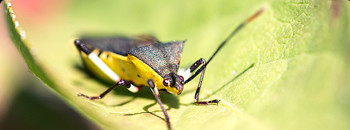Written by: Bobby Kossowicz, mother of two, Branchburg, New Jersey
Bobby Kossowicz is a mother of two from Branchburg, New Jersey, who has past personal experience with pests and the importance of controlling them. Before becoming a full-time mom, Bobby worked in the pest control industry, and she combines her professional experience with her perspective as a mom to share the importance of understanding pests and how to protect your family from them.
It was a beautiful morning and the crisp, cool air greeted the Mom’s Club of Branchburg, N.J., as we gathered at the park to learn how to protect ourselves and our families from ticks and tick-borne illnesses. Jennifer Reid from the Ridgefield, Conn. Health Department joined us to teach us how to enjoy the outdoors safely with our families.
Having spent 15 years in the pest control industry myself, I thought I was a pretty savvy mom when it came to ticks. But today, I learned just how serious Lyme disease can be, the best ways to truly protect myself and my family, and what to do if I do spot a tick on a family member.
As of 2010, the state of New Jersey had the highest reported number of incidences to the CDC. I knew we had a tick problem and living in a rural area with high deer populations had always had me concerned. However, after hearing Jennifer’s story, my concern with Lyme disease and protecting my family from ticks reached a whole new level.
Another mom’s lessons
Jennifer talked about how she and her family enjoyed the outdoors and spent as much time as possible playing sports, hiking and horseback riding, but then suddenly in their teen years, one by one, her children became ill, as did Jennifer. Their symptoms varied from aches and exhaustion to changes in demeanor, and after several doctor’s appointments came the test results common to them all: Lyme disease. The disease affected each of them differently but recovery took years — not weeks. One child still feels the effects today, 10 years after the diagnosis. I had no idea Lyme disease was not easily treated with a round of antibiotics. I didn’t understand the risk of it becoming a chronic disease with possible life-long implications. Suddenly our job as our children’s protectors became even more apparent to us when it comes to ticks.
Jennifer was obviously a changed woman from the experience and put her time and energy into educating others. She, along with two other women, applied for and received a $50,000 state grant for a Lyme Disease Prevention Program and today exists as BLAST, the details of the program can be found at their website: http://www.ridgefieldct.org/content/46/6311/6347/8905.aspx.
Inspect and protect
The truth was we had all spotted a tick on ourselves or our children at some point in time. So, what was the best guideline to follow if you spot a tick? Jennifer taught us how to properly remove ticks from ourselves to minimize the risk of infection. The CDC Guidelines for removing ticks can be found here: http://www.cdc.gov/ticks/removing_a_tick.html.
Many of us were surprised that the remedies we had heard growing up about using matches, Vaseline or other home remedies were not a good idea. We also were surprised to learn you should not simply discard ticks after removing them. There are labs that will test for Borrelia Burgdorferi, the bacteria that cause Lyme disease. New Jersey Laboratories is one such lab – you can learn more about here: http://njlabs.com/ticktesting/myths.cfm. She also cautioned us to watch for changes in behavior in our children and to trust our motherly instinct, insisting on further testing. Unfortunately, Lyme disease tests are not full-proof and false negatives can happen.
Taking action
With Jennifer’s BLAST program in hand as our new protocol to protect our families, the conversation amongst the Mom’s Club was lively and full of ideas. We discussed how to protect our children. Could we negotiate with a local pest control company for a reduced rate on a perimeter spray of our yards? Would a service project to clean up the debris in our parks (that serve as a breeding ground for ticks) help reduce tick populations locally? I believe in the power of moms, and I could tell that Jennifer’s talk today ignited a fire in all of us to spread the word about the danger of ticks and Lyme disease. My wish is that we can carry the torch that Jennifer has taken up to protect families from Lyme disease. For more information about the Connecticut Health Department’s BLAST program visit: http://www.ridgefieldct.org/content/46/6311/6347/8905.aspx

